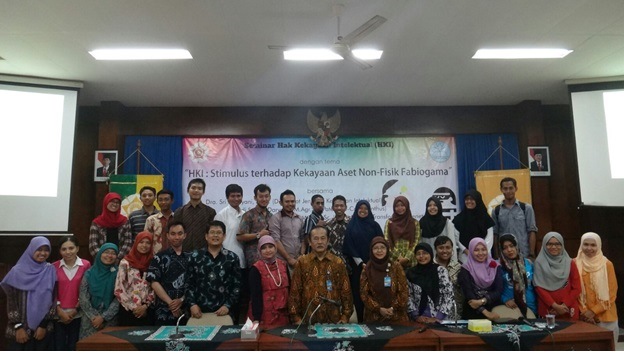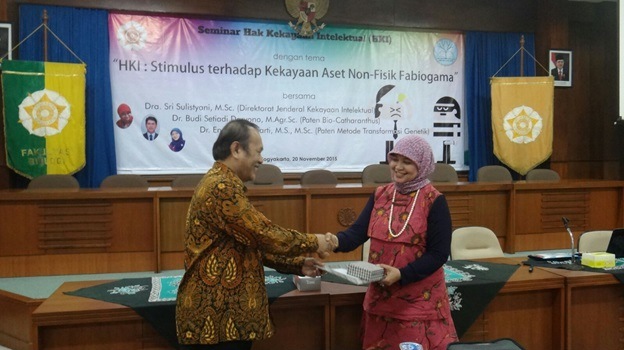Faculty of Biology introduced Intellectual Property Rights (IPR) to its students through the “IPR Seminar” organized by the Graduate Student Family (KMP) in the Lower Meeting Room Faculty of Biology, Friday (20/11). IPR seminar was attended by undergraduate and post-graduate students of Faculty of Biology.
The seminar entitled “IPR as non-physical assets of Fabiogama” was presenting Dra. Sri Sulistyani, M.Sc. (Patent examiner Directorate General of Intellectual Property), Dr. Budi Setiadi Daryono, M.Agr.Sc. (Bio-Catharantus patent owner) and Dr. Endang Semiarti, M.S., M.Sc. (the patent owner of orchid plant genetic transformation method) as speakers.
IPR Seminar was officially opened by the Dean of the Faculty of Biology, Prof. Dr. Suwarno Hadisusanto, S.U. In his speech, Suwarno said that the Indonesian people have lower levels of awareness about Intellectual Property Rights compared to other countries. He hopes that this activity will increase the awareness of IPR.
“Actually, we have much potential in Copyright and Patents. However, due to the lack of awareness of IPR, causing us to never take care of the legal protection. We are still inferior to other countries, such as China, Japan and Singapore on awareness of Copyright and Patent,” said Suwarno on Tuesday (24/11).
Meanwhile, Dr. Budi Setiadi Daryono, M.Agr.Sc. (Bio-Catharantus patent owner) thinks that intellectual property rights is an exclusive right granted to a person or group of persons on the work of their creation or invention. IPR has many benefits ranging from appreciation of the work to wealth.
“The first thing that becomes the benefits of IPR is an appreciation for our hard work. Furthermore, it made money. Call it, Raditya Dika, a billionaire for the copyright of his books,” said Budi.
Likewise, Endang Semiarti, added intellectual property rights may also be the discovery of new methods, such as genetic transformation method patents.
At the end, Sri Sulistyani said there are two categories that can be patented by Fabiogama. The first category is the product, for example, strains of microorganisms, DNA sequences, recombinant vectors, plant extracts, as well as the composition of the food, and so on. The second category is the process, for example the isolation processes, the process of producing the compound using microorganisms, food manufacturing process, as well as the use of micro-organisms to control pests, and so on. (Adel)



